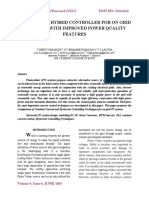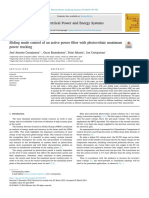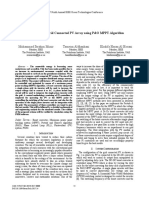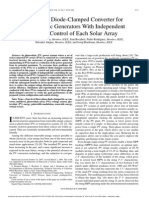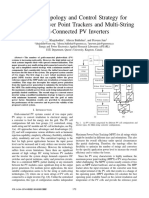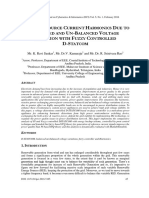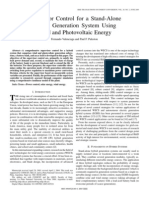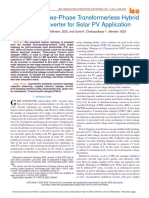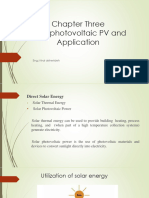2006 Ciobotaru EPE Ju
2006 Ciobotaru EPE Ju
Uploaded by
sj.saravanan9540Copyright:
Available Formats
2006 Ciobotaru EPE Ju
2006 Ciobotaru EPE Ju
Uploaded by
sj.saravanan9540Copyright
Available Formats
Share this document
Did you find this document useful?
Is this content inappropriate?
Copyright:
Available Formats
2006 Ciobotaru EPE Ju
2006 Ciobotaru EPE Ju
Uploaded by
sj.saravanan9540Copyright:
Available Formats
See discussions, stats, and author profiles for this publication at: https://www.researchgate.
net/publication/224642931
Control of Single-Stage Single-Phase PV Inverter
Article in Epe Journal · September 2006
DOI: 10.1080/09398368.2006.11463624 · Source: IEEE Xplore
CITATIONS READS
202 7,202
3 authors, including:
Mihai Ciobotaru F. Blaabjerg
Macquarie University Aalborg University
123 PUBLICATIONS 5,886 CITATIONS 3,294 PUBLICATIONS 143,903 CITATIONS
SEE PROFILE SEE PROFILE
Some of the authors of this publication are also working on these related projects:
Multi-Physics of High Power Density Power Electronic Systems View project
HARMONY - Harmonic Identification, Mitigation and Control in Power Electronics Based Power Systems View project
All content following this page was uploaded by Mihai Ciobotaru on 28 May 2016.
The user has requested enhancement of the downloaded file.
Blaabjerg EPE journal 25/09/06 9:58 Page 2
Mihai Ciobotaru, Remus Teodorescu, Frede Blaabjerg
Control of Single-Stage Single-Phase PV Inverter
Mihai Ciobotaru, Remus Teodorescu and Frede Blaabjerg, Institute of Energy Technology, Aalborg University, Aalborg, Denmark
Keywords: Distributed power generation, Harmonics, Photovoltaic, Single phase system, Solar Cell System
Abstract
In this paper the issue of control strategies for single-stage photovoltaic (PV) inverter is addressed. Two different current
controllers (the classical proportional-integral (PI) and the novel proportional-resonant (PR) controllers) have been
implemented and an experimental comparison between them has been made. A complete control structure for the single-
phase PV system is also presented. The superiority of the PR controller is demonstrated with respect to the PI controller
in terms of harmonic current rejection and the capability to remove the steady-state error without using the voltage feed-
forward (VFF). The control strategy was successfully tested on a real 1.5 kW PV inverter.
Introduction
The market for PV power applications continues to develop at a
high rate [1]. Between 2002 and 2003 the total installed capacity
in the International Energy Agency (IEA) PhotoVoltaic Power
Systems (PVPS) countries grew by 36 %, reaching 1 809 MW.
Moreover, the price level of the PV modules and the system costs
(inverter included) has decreased significantly [2]. The use of PV
systems connected in parallel with the mains was simplified and
is often supported by incentives from utilities and/or governmental Fig. 1: Power electronic system with the grid, source (PV
bodies. Before connecting a PV system to the power network, the array), power converter and control
d.c. voltage of the solar modules must be converted into an a.c.
voltage. Some protection systems are required to prevent damage
in the PV system caused by the utility network and vice versa. The
PV systems require standards addressing the use and the perfor-
mance of grid-connected PV inverters, thus ensuring the safety
and quality of the products.
The purpose of the power electronics in PVPS is to convert the
d.c. current from the PV panels into an a.c. current to the grid,
with the highest possible efficiency, the lowest cost and keep a
superior performance. The basic interfacing is shown in Fig. 1.
Fig. 2: The voltage source PV inverter connected to the grid
A controversial issue for PV inverters is the current harmonics through an LCL filter
level. The IEEE 929 standard permits a limit of 5 % for the cur-
rent total harmonic distortion (THD) factor with individual limits
of 4 % for each odd harmonic from 3rd to 9th and 2 % for 11th to equivalent a.c.-compensator having the same frequency response
15th while a recent draft of European IEC61727 suggests almost characteristics in the bandwidth of concern.
the same thing as previously mentioned. These levels are far more
stringent than other domestic appliances, like IEC61000-3-2, as This paper is aimed at presenting a single-stage converter for single-
PV systems are viewed as generation sources and so are subject to phase PV systems. Two different current controllers have been
higher standards than load systems. implemented and an experimental comparison between them has
been made. A complete control structure for the single-phase PV
For current-controlled PV inverters in most of the cases a PI con- system is also presented. An incremental conductance method has
troller with grid voltage feed-forward (VFF) is used [3], [4], but been used in order to track the Maximum Power Point Tracker
this solution exhibits two well known drawbacks (due to the poor (MPPT) of the PV characteristic. In order to get a clean sinusoidal
performance of the integral action): inability of the PI controller current reference (synchronized with the grid voltage) a phase-
to track a sinusoidal reference without steady-state error and poor locked loop (PLL) based on a delay structure is used. The conclu-
disturbance rejection capability. An alternative solution in order to sions are presented in the final part of the paper.
alleviate the PI’s drawbacks is presented in [5], where a second
order generalized integrator (GI) can be used. The GI is a double
integrator that achieves an “infinite” gain at a certain frequency System description
(resonance frequency), and almost no attenuation exists outside
this frequency. Thus, it can be used as a notch filter in order to Usually the power converter interface from the d.c. source to the
compensate the harmonics in a very selective way. Another load and/or to the grid consists of a two stage converter: the d.c.-
approach reported in [6] where a new type of stationary-frame d.c. converter and the d.c.-a.c. converter. An alternative solution
regulators called Proportional Resonant (PR) is introduced. In this could be the use of a single-stage converter where the d.c.-d.c.
approach the classical PI d.c.-compensator is transformed into an converter is avoided and in order to ensure the necessary d.c. volt-
20 EPE Journal ⋅ Vol. 16 ⋅ no 3 ⋅ September 2006
Blaabjerg EPE journal 25/09/06 9:58 Page 3
Control of Single-Stage Single-Phase PV Inverter
Fig. 3: Control diagram of the PV energy conversion system
Fig. 4: General structure of a single phase PLL including grid voltage monitoring
age level the PV array can be a string of PV panels or a multitude can produce stability problems and special control design is
of parallel strings of PV panels. In the classical solution with two- required [7]. The control structure of the PV power conversion
stage converter, the d.c.-d.c. converter requires several additional system is shown in Fig. 3.
devices producing a large amount of conduction losses, sluggish
transient response and high cost while the advantages of the single- The main elements of the control structure are the synchronization
stage converters are: good efficiency, a lower price and easier algorithm based on PLL, the MPPT, the input power control, the
implementation. The disadvantages of the single-stage converter grid current controller including PWM.
are the fact that the PV panels are in series and if shading occurs
on one or several PV panels then the efficiency of the whole
system is reduced. PLL structure
As shown in Fig. 2, the PV inverter system consists of a solar The PLL is used to provide a unity power factor operation which
panel string and a d.c. link capacitor Cdc on the d.c. side with an involves synchronization of the inverter output current with the
output a.c. filter (LCL), insulation transformer and grid connection grid voltage and to give a clean sinusoidal current reference. The
on the a.c. side. The number of panels in the string has to ensure PI controller parameters of the PLL structure are calculated in
a d.c. voltage higher than the a.c. peak voltage at all time. The such a way that the settling time and the damping factor of this
energy conversion from d.c. to a.c. side is made by a single-phase PLL structure can be set directly. The PLL structure is also used
voltage source inverter. The used solar panel string consists of for grid voltage monitoring in order to get the amplitude and
sixteen uniserial PV panels (120 W for each panel). the frequency values of the grid voltage. The general form of the
PLL structure including grid voltage monitoring is presented in
Fig. 4 [8].
Control strategy
For the grid-connected PV inverters in the power range of 1-5 kW, MPPT algorithm
the most common control structure for the d.c.-a.c. grid converter
is a current-controlled H-bridge PWM inverter having a low-pass The task of the MPPT in a PV energy conversion system is to tune
output filter. Typically L filters are used but the new trend is to use continuously the system so that it draws maximum power from the
LCL filters that have a higher order (3rd) which leads to more solar array regardless of weather or load conditions. Since the
compact design. The drawback is its resonance frequency which solar array has a non-ideal voltage-current characteristics and the
EPE Journal ⋅ Vol. 16 ⋅ no 3 ⋅ September 2006 21
Blaabjerg EPE journal 25/09/06 9:58 Page 4
Mihai Ciobotaru, Remus Teodorescu, Frede Blaabjerg
conditions such as irradiance, ambient temperature, and wind that
affect the output of the solar array are unpredictable, the tracker
should deal with a nonlinear and time-varying system. The con-
ventional MPPT algorithms are using dP/dV = 0 to obtain the
maximum power point output. Several algorithms can be used in
order to implement the MPPT as follows [9]: perturb & observe,
incremental conductance, parasitic capacitance and constant voltage,
but only the first two are the most frequently used.
The incremental conductance algorithm has been chosen as a
MPPT strategy in this paper. This algorithm has advantages com-
pared to perturb & observe as it can determine when the MPPT
has reached the MPP, where perturb and observe oscillates around
the MPP. Also, incremental conductance can track rapidly the
increase and decrease of irradiance conditions with higher accuracy
than perturb & observe. One disadvantage of this algorithm is the
increased complexity when compared to perturb & observe. This
increases the computational time and slows down the sampling
frequency of the array voltage and current.
The flowcharts of the perturb & observe and of the incremental
conductance algorithm are shown in Fig. 5 [10], where Vk and Ik a)
are the momentary voltage and current of the PV array and Vk-1,
Ik-1 are the previous sampled voltage and current, respectively.
The dP/dV term can be replaced by I + (∆I/∆V) ⋅ V. The output of
the MPPT is the d.c. voltage reference (V*pv).
Input power control
The control strategies of input power in the case of a power con-
figuration of PV system without d.c.-d.c. converter are presented
in the following section. In Fig. 6 a new control strategy of input
power is proposed. The new element introduced is the power feed-
forward. The computed value of the current amplitude reference
using the PV Power and the RMS value of the a.c. voltage (Vac RMS) is
added to the output value of the d.c. voltage controller (Îr) resulting
in the a.c. current amplitude reference (Îref). Using the input power
feed-forward the dynamic of the PV system is improved being
known the fact that the MPPT is rather slow. The d.c. voltage
controller ensures a quick response of the PV system at a sudden
change of the input power.
Grid current controller
Classical PI control with grid voltage feed-forward (Vff) as
depicted in Fig. 7a, is commonly used for current-controlled PV
inverters.
The PI current controller GPI(s) is defined as:
Ki
GPI ( s) = K p + (1) b)
s
In order to get a good dynamic response, a grid voltage feed-for- Fig. 5: Flowcharts of the perturb & observe a) and incremen-
ward is used, as depicted in Fig. 7a. This leads in turn to stability tal conductance algorithms b)
problems related to the delay introduced in the system by the voltage
feedback filter. In order to alleviate this problem an advanced
filtering method for the grid voltage feed-forward should be con-
sidered. The Root-locus and Bode diagram analysis of the PI con-
troller is presented in Fig. 8.
As it has been mentioned in the introduction of this paper, an alter-
native solution for the poor performances of the PI controller is
the PR controller. The current loop of the PV inverter with PR
controller is shown in Fig. 7b.
The PR current controller Gc(s) is defined as [5, 7]: Fig. 6: New control structure of controlling the input power.
A feed-forward of input power is used
22 EPE Journal ⋅ Vol. 16 ⋅ no 3 ⋅ September 2006
Blaabjerg EPE journal 25/09/06 9:58 Page 5
Control of Single-Stage Single-Phase PV Inverter
a) b)
Fig. 7: The current loop of PV inverter: a) with PI controller; b) with PR controller
Fig. 8: PI current controller – Root-locus and Bode diagram analysis
s
Gc ( s) = K p + K i (2) The current error-disturbance ratio rejection capability at null
s 2 + ω o2 reference is defined as:
The harmonic compensator (HC) Gh(s) is defined as [7]: ε ( s) Gf ( s)
= (5)
vg ( s ) 1 + (Gc ( s) + Gh ( s)) ⋅ Gd ( s) ⋅ Gf ( s)
ii* = 0
∑
s
Gh ( s) = K ih (3)
h = 3,5,7
s 2 + (ω o h) 2 where: ε is the current error and the grid voltage vg is considered
as the disturbance for the system.
The HC is designed to out compensate the selected harmonics 3rd, In Fig. 9 is presented the Bode diagram of the disturbance rejec-
5th and 7th as they are the most predominant harmonics in the cur- tion for the PI and PR controllers. It can very easily be noticed that
rent spectrum. the PI rejection capability is worse in comparison with the PR.
Thus, it is demonstrated the superiority of the PR controller with
A processing delay, usually equal to Ts for the PWM inverters [4], respect to the PI in terms of harmonic current rejection.
is introduced in Gd(s). The filter transfer function Gf(s) is
expressed in (4) [11]. The Root-locus and Bode diagram analysis of the PR+HC con-
Gf ( s) =
ii ( s)
=
1 s + ( 2 2
zLC ) (4)
troller are presented in Fig. 10.
(
vi ( s) Li s s 2 + ω res
2
) The size of the proportional gain Kp from PR controller deter-
mines the bandwidth and stability phase margin [5], in the same
way as for the PI controller. As it can be observed from the open-
( Li + Lg ) ⋅ zLC
2 loop Bode diagram (Fig. 10) the phase margin (PM) is determined
[ ]
−1
where 2
zLC = Lg Cf and, ω res
2
= to be equal with 60.6 degrees, indicating a good stability of the
Li system. Also, the dominant poles of the controller are well
damped as it can be seen in Fig. 10 exhibiting a damping factor
where Li, Lg and Cf are shown in Fig. 2. Lg includes the grid equal with 0.7.
impedance due to the transformer and the grid lines.
EPE Journal ⋅ Vol. 16 ⋅ no 3 ⋅ September 2006 23
Blaabjerg EPE journal 25/09/06 9:58 Page 6
Mihai Ciobotaru, Remus Teodorescu, Frede Blaabjerg
Fig. 9: Bode diagram of the disturbance rejection (current error ratio disturbance) of the PR+HC (3rd, 5th and 7th) and PI current
controllers
Fig. 10: PR current controller – Root-locus and Bode diagram analysis
Experimental results The plotted results have been captured using the graphical inter-
face of the dSPACE system (Control Desk) and then exported to
A single-stage grid-connected PV inverter (1.5 kW power range) Matlab workspace for plotting.
has been built in order to analyze the PV system performance, as
depicted in Fig. 11a. The system is dSPACE based and voltage The solar panels string mounted on the roof of the laboratory are
source inverter (VSI) is controlled using a unipolar PWM to place presented in the Fig. 11b [12].
the harmonics on the high frequency side making them easier to
filter. The parameters of the LCL filter were: Li = 1426 µH, The grid current and grid voltage at 1.5 kW for PI, PR and PR+HC
Cac = 2.2 µF, Lg = 713 µH. The power stage of a Danfoss VLT controllers are presented in Fig. 12 a), b) and c). As it can be seen
5004 rated 400 V/10A was used. The switching frequency of the a much lower THD is obtained with the PR+HC controller. The
inverter was 10 kHz. The control algorithm shown in Fig. 3 was grid current response at a 5 A step in the current reference is pre-
implemented using the dSPACE DS1103 platform. For higher sented for the PI (Fig. 12d), PR (Fig. 12e) and PR+HC (Fig. 12f).
power, the LCL filter needs to be redesigned.
As it can be observed the PR and PR+HC controller yields a
The system was tested in the following condition: the open circuit smaller overshoot than the PI controller.
d.c. voltage provided by the uniserial sixteen PV panels was
around 660 V, the RMS value of the grid voltage was Vg = 225 V In Fig. 13, a comparison of the spectrum for PI, PR and PR+HC
with a THD of 2.2 % voltage background distortion. The grid in the lower frequency region is presented.
impedance was measured to 1.2 Ω with a series inductance of
2.1 mH due to the insulation transformer, used in order to connect Using PI controller with VFF a current THD of 5.8% has been
the PV system to the grid, and the grid inductance was measured obtained while in the case of the PR controller the measured
to 50 µH. The total Lg will be 0.713 mH + 2.1 mH = 2.813 mH. current THD was 9.7 %. Adding the HC for the PR controller a
drastic attenuation of the current THD can be observed, decreasing
For small variations of Lg the PR controller behavior is not affected, to 0.5 %.
but for large variations of Lg the stability of the current controller
decreases and an adaptive tuning of the PR controller can be con-
sidered.
24 EPE Journal ⋅ Vol. 16 ⋅ no 3 ⋅ September 2006
Blaabjerg EPE journal 25/09/06 9:58 Page 7
Control of Single-Stage Single-Phase PV Inverter
a) b)
Fig. 11: a) Test setup for 1.5 kW PV inverter; b) The solar panels string mounted on the roof of the laboratory.
a) d)
b) e)
c) f)
Fig. 12: Grid current (marked) and grid voltage at 1.5 kW for PI a), PR b) and PR+HC c) controllers. Grid current response
(marked) at a 5 A step in the current reference for PI d), PR e) and PR+HC f) controllers
EPE Journal ⋅ Vol. 16 ⋅ no 3 ⋅ September 2006 25
Blaabjerg EPE journal 25/09/06 9:58 Page 8
Mihai Ciobotaru, Remus Teodorescu, Frede Blaabjerg
[9] D.P. Hohm and M.E. Ropp. Comparative Study of Maximum
Power Point Tracking Algorithms Using an Experimental,
Programmable, Maximum Power Point Tracking Test Bed, Proc. of
Photovoltaic Specialists Conference, 2000, pp.1699 – 1702.
[10] Y.C. Kuo and T.J. Liang. Novel Maximum-Power-Point-Tracking
Controller For Photovoltaic Energy Conversion System, IEEE Trans-
actions on Industrial Electronics, Vol. 48, No. 3 , 2001 pp. 594 – 601.
[11] M. Liserre, F. Blaabjerg and S. Hansen. Design and Control of an LCL-
filter Based Active Rectifier, Proc. of IAS’01, Vol. 1, pp. 299-307.
[12] R. Teodorescu and F. Blaabjerg. Photovoltaic Systems Are With
Power Electronics, IEEE Power Electronics Society Newsletter,
Forth Quarter 2005, Vol. 17, No. 4, ISSN 1054-7231.
Fig. 13: Measured grid current harmonics normalized to the
fundamental for PI, PR and PR+HC controllers The Authors
Conclusion Frede Blaabjerg, (S'86-M'88-SM'97-F’03)
received the M.Sc.EE. from Aalborg University,
An alternative solution using a single-stage converter, where the Denmark in 1987, and the PhD. degree from the
d.c.-d.c. converter is avoided, has been developed and successfully Institute of Energy Technology, Aalborg
tested on a dSPACE controlled 1.5kW single-phase PV inverter. University, in 1995. He was employed at ABB-
The advantages of the single-stage converters are: good efficiency, Scandia, Randers, from 1987-1988. During
a lower price and easier implementation, while the main disad- 1988-1992 he was a PhD student at Aalborg
vantage is the fact that the PV panels are in series and if the University. He became an Assistant Professor in
shading occurs on one or several PV panels then the efficiency of 1992 at Aalborg University, in 1996 Associate
the whole system is reduced. Professor and in 1998 full professor in power
electronics and drives the same place. In 2006 he
It has been demonstrated that the PR+HC controller gives better became the Dean of Faculty of Engineering and
Science at Aalborg University. His research areas are in power electronics,
performances then the classical PI controller for the grid current static power converters, ac drives, switched reluctance drives, modeling,
loop. The two well known drawbacks of the PI controller are: - characterization of power semiconductor devices and simulation, wind
steady-state error; and - poor harmonics rejection capability. The turbines and green power inverter. He is the author or co-author of more
steady-state error can be overcome by the PR controller. The PR than 300 publications in his research fields.
controller is able to remove the steady-state error without using
VFF, which makes it more reliable. By adding the selective HC to
the PR controller, a very good rejection for the dominant harmon- Mihai Ciobotaru was born in 1979 in Galati,
ics can be obtained. Romania. He received his B.Sc. and M.Sc.
degrees both in Electrical Engineering from
"Dunarea de Jos" University of Galati in 2002
References and 2003 respectively. From 2003 to 2004 he was
employed as a teaching assistant at the
[1] F. Blaabjerg, Zhe Chen and S.B.Kjaer. Power electronics as efficient Department of Electrotechnics, Electrical
interface in dispersed power generation systems, IEEE Transactions Machinery and Drives at the same institution. In
on Power Electronics, Vol. 19, Issue 5, 2004, pp. 1184 - 1194 . February 2004, he joined the Institute of Energy
Technology, Aalborg University, Denmark as a
[2] S.B. Kjaer, J.K. Pedersen and F. Blaabjerg. A review of single-phase guest researcher working on single-phase grid
grid-connected inverters for photovoltaic modules, IEEE Transactions connected inverter systems and since June 2004
on Industry Applications, Vol. 41, Issue 5, 2005, pp. 1292 - 1306 . he has been enrolled in a Ph.D. program with a provisional thesis title:
[3] M. Kazmierkovski, R. Krishnan, F. Blaabjerg. Control in Power "Reliable Grid Condition Detection and Control for Single-Phase
Electronics, Selected Problems, Academic Press 2002, ISBN 0-12- Distributed Power Generation Systems".
402772-5.
[4] C. Cecati, A. Dell'Aquila, M. Liserre and V. G. Monopoli. Design Remus Teodorescu received the Dipl.Ing. degree
of H-bridge multilevel active rectifier for traction systems, IEEE in electrical engineering from Polytechnical
Trans. on Ind. App., Vol. 39, Sept./Oct. 2003, pp. 1541-1550. University of Bucharest in 1989, and PhD.degree
[5] X. Yuan, W. Merk, H. Stemmler, J. Allmeling. Stationary-Frame from University of Galati, Romania, in 1994.
Generalized Integrators for Current Control of Active Power Filters From 1989 to 1990, he worked for Iron and Steel
with Zero Steady-State Error for Current Harmonics of Concern Plant Galati and then he moved to Galati
University where he worked as an assistant pro-
Under Unbalanced and Distorted Operating Conditions, IEEE
fessor with Electrical Engineering Department.
Trans. on Ind. App., Vol. 38, No. 2, Mar./Apr. 2002, pp. 523 – 532. In 1998, he joined Aalborg University, Institute
[6] D. N. Zmood and D. G. Holmes. Stationary Frame Current Regula- of Energy Technology, Power Electronics Section
tion of PWM Inverters with Zero Steady-State Error, IEEE Trans. on where he currently works as an Associate
Power Electronics, Vol. 18, No. 3, May 2003, pp. 814 – 822. Professor. His research areas include power con-
[7] R. Teodorescu, F. Blaabjerg, M. Liserre, U. Borup. A New Control verters for renewable energy systems (PV, wind turbines), electrical
Structure for Grid-Connected PV Inverters with Zero Steady-State drives. He has coauthored more than 100 technical papers, 12 of them
Error and Selective Harmonic Compensation, Proc. of APEC’04, published in journals. He is coauthor of 2 books and 5 patents. He
received the Technical Committee Prize Paper Awards, IEEEIAS‚ 98 and
Vol. 1, pp. 580-586.
OPTIM-ABB Prize paper Award at OPTIM 2002. He is a Senior Member
[8] M. Ciobotaru, R. Teodorescu and F. Blaabjerg, A new single-phase of IEEE, Associate Editor for IEEE Transactions of Power Electronics
PLL structure based on second order generalized integrator, Letters and chair of IEEE Danish IAS/IES/PELS chapter.
Record of IEEE PESC 2006, Korea, p. 1511-1516.
26 EPE Journal ⋅ Vol. 16 ⋅ no 3 ⋅ September 2006
View publication stats
You might also like
- Installation Operation and Maintenance of Solar PV Microgrid Systems A Handbook For TechniciansDocument139 pagesInstallation Operation and Maintenance of Solar PV Microgrid Systems A Handbook For TechniciansYousef YaserNo ratings yet
- Modeling and Control of DC-DC Boost Converter Using K-Factor Control For MPPT of Solar PV SystemDocument6 pagesModeling and Control of DC-DC Boost Converter Using K-Factor Control For MPPT of Solar PV SystemHoang ManhNo ratings yet
- High-Efficiency Two-Stage Three-Level Grid-Connected Photovoltaic InverterDocument10 pagesHigh-Efficiency Two-Stage Three-Level Grid-Connected Photovoltaic InvertergopalNo ratings yet
- Control of Single Stage Single Phase PV InverterDocument8 pagesControl of Single Stage Single Phase PV Inverterphee210004No ratings yet
- Reactive Power Control of Grid-Connected Photovoltaic Micro-Inverter Based On Third-Harmonic InjectionDocument13 pagesReactive Power Control of Grid-Connected Photovoltaic Micro-Inverter Based On Third-Harmonic InjectionInternational Journal of Power Electronics and Drive SystemsNo ratings yet
- Closed Loop Control of Grid Connected PV InverterDocument33 pagesClosed Loop Control of Grid Connected PV InverterWA Q AS100% (1)
- 48 An Improved Maximum Power Point Tracking For PDFDocument10 pages48 An Improved Maximum Power Point Tracking For PDFSouhaib LoudaNo ratings yet
- Final Year Project Report Chapter 1,2Document13 pagesFinal Year Project Report Chapter 1,2Dhanush NNo ratings yet
- GridDocument6 pagesGridgiongan342No ratings yet
- 189 839 1 PB2Document10 pages189 839 1 PB2vivian phamNo ratings yet
- 824 June 2019Document8 pages824 June 2019Katta VenkateshNo ratings yet
- Grid Connected Battery SystemDocument34 pagesGrid Connected Battery SystemmygodspNo ratings yet
- Research PaperDocument8 pagesResearch PaperGiridharNo ratings yet
- Hardware Implementation and Control Design of Generator Emulator in Multi-Converter SystemDocument11 pagesHardware Implementation and Control Design of Generator Emulator in Multi-Converter SystemSagar LakadeNo ratings yet
- Red DEv and Tripathi Journal PaperDocument10 pagesRed DEv and Tripathi Journal PaperMichael Zontche BernardNo ratings yet
- 1 s2.0 S0142061523004568 MainDocument10 pages1 s2.0 S0142061523004568 MainMinh Tạ ĐứcNo ratings yet
- Boost Current Multilevel Inverter and Its Application On Single-Phase Grid-Connected Photovoltaic SystemsDocument9 pagesBoost Current Multilevel Inverter and Its Application On Single-Phase Grid-Connected Photovoltaic SystemsShaju NaduvilNo ratings yet
- Low Voltage Ride-Through of Single-Phase Transformerless Photovoltaic InvertersDocument10 pagesLow Voltage Ride-Through of Single-Phase Transformerless Photovoltaic InvertershassanNo ratings yet
- Power Quality Improvement of Grid-Connected Photovoltaic Systems Using PI-fuzzy ControllerDocument14 pagesPower Quality Improvement of Grid-Connected Photovoltaic Systems Using PI-fuzzy ControllerInternational Journal of Applied Power EngineeringNo ratings yet
- Active Damping Method For Voltage Source Inverter-Based Distributed Generator Using Multivariable Finite-Control-Set Model Predictive ControlDocument11 pagesActive Damping Method For Voltage Source Inverter-Based Distributed Generator Using Multivariable Finite-Control-Set Model Predictive ControlInternational Journal of Power Electronics and Drive SystemsNo ratings yet
- Iccicct - 507 PDFDocument5 pagesIccicct - 507 PDFGlan DevadhasNo ratings yet
- Frequency and Voltage Stabilit-IRO-Journals-4 4 4Document20 pagesFrequency and Voltage Stabilit-IRO-Journals-4 4 4aliebadizahedan.375No ratings yet
- Tradeoff Lucas PDFDocument11 pagesTradeoff Lucas PDFGustavo CunhaNo ratings yet
- Document For A Three Phase SPV SystsemDocument49 pagesDocument For A Three Phase SPV SystsemBhuviNo ratings yet
- Power Quality Stabilization System For Grid Connected Large-Scale Solar Power SystemDocument12 pagesPower Quality Stabilization System For Grid Connected Large-Scale Solar Power SystemInternational Journal of Power Electronics and Drive SystemsNo ratings yet
- 1 s2.0 S0142061518338122 Main PDFDocument12 pages1 s2.0 S0142061518338122 Main PDFAmit sahaNo ratings yet
- A Robust Nonlinear Control Strategy of A PV System Connected To The Three-Phase Grid Based On Backstepping and PSO TechniqueDocument15 pagesA Robust Nonlinear Control Strategy of A PV System Connected To The Three-Phase Grid Based On Backstepping and PSO TechniqueInternational Journal of Power Electronics and Drive SystemsNo ratings yet
- A Study On Grid Connected PV System: Under Supervision by EachDocument14 pagesA Study On Grid Connected PV System: Under Supervision by EachAnan OthmanNo ratings yet
- A Cascaded Photovoltaic System Integrating Segmented Energy Storages With Self-Regulating Power Allocation Control and Wide Range Reactive Power CompensationDocument15 pagesA Cascaded Photovoltaic System Integrating Segmented Energy Storages With Self-Regulating Power Allocation Control and Wide Range Reactive Power Compensation戴子翔No ratings yet
- Hindawi Publishidng CorporationDocument27 pagesHindawi Publishidng CorporationAtul ChauhanNo ratings yet
- Ijird, 50Document24 pagesIjird, 50oke temitope oluwasanmiNo ratings yet
- Literature SurveyDocument4 pagesLiterature SurveyG Vignesh100% (1)
- Thesis On HERIC Inverter Closed Loop ControlDocument41 pagesThesis On HERIC Inverter Closed Loop ControlGiridharNo ratings yet
- A New Controller Scheme For Photovoltaics PowerDocument10 pagesA New Controller Scheme For Photovoltaics PowerHakan PolatkanNo ratings yet
- AIMS Energy - FinalDocument15 pagesAIMS Energy - FinalKhan farazNo ratings yet
- Dual-Input LLCDocument11 pagesDual-Input LLCVishal PusadkarNo ratings yet
- Midterm Report: in Electrical EngineeringDocument11 pagesMidterm Report: in Electrical Engineeringdr.Sabita shresthaNo ratings yet
- Control of Grid Connected PV Array Using P&O MPPT AlgorithmDocument7 pagesControl of Grid Connected PV Array Using P&O MPPT AlgorithmHương B DlightNo ratings yet
- Control H BridgeDocument5 pagesControl H BridgeFahad Al-shammeriNo ratings yet
- 2-Stability and Reliability Improvement in Solar Wind Hybrid Power System With Battery Energy Storage StationDocument9 pages2-Stability and Reliability Improvement in Solar Wind Hybrid Power System With Battery Energy Storage StationEngrImranKhanNo ratings yet
- An Integrated Step-Up Inverter Without Transformer and Leakage Current For Grid-Connected Photovoltaic SystemDocument14 pagesAn Integrated Step-Up Inverter Without Transformer and Leakage Current For Grid-Connected Photovoltaic SystemroyNo ratings yet
- Wind ProjectDocument11 pagesWind ProjectjyotiblossomsNo ratings yet
- B 0451217Document6 pagesB 0451217International Organization of Scientific Research (IOSR)No ratings yet
- Voltage Stability Analysis of Grid Connected Photovoltaic Power Systems Using CpflowDocument4 pagesVoltage Stability Analysis of Grid Connected Photovoltaic Power Systems Using CpflowRafael RoratoNo ratings yet
- SEPIC Converter Based Photovoltaic System With Particle Swarm Optimization MPPTDocument6 pagesSEPIC Converter Based Photovoltaic System With Particle Swarm Optimization MPPTWARSE JournalsNo ratings yet
- A Novel Topology and Control Strategy For Maximum Power Point Trackers and Multi-String Grid-Connected PV InvertersDocument6 pagesA Novel Topology and Control Strategy For Maximum Power Point Trackers and Multi-String Grid-Connected PV Inverterswalidghoneim1970No ratings yet
- Reducing Source Current Harmonics Due To Balanced and Un-Balanced Voltage Variation With Fuzzy Controlled D-StatcomDocument14 pagesReducing Source Current Harmonics Due To Balanced and Un-Balanced Voltage Variation With Fuzzy Controlled D-StatcomJames MorenoNo ratings yet
- Interleaved Luo Report 2Document51 pagesInterleaved Luo Report 2VijayNo ratings yet
- The Scientific World Journal - 2015 - Pandu - A Novel Multiobjective Control of DVR To Enhance Power Quality of SensitiveDocument10 pagesThe Scientific World Journal - 2015 - Pandu - A Novel Multiobjective Control of DVR To Enhance Power Quality of SensitiveSathish BabuNo ratings yet
- Design of PV System With Double Boost ConverterDocument53 pagesDesign of PV System With Double Boost ConverterBalamurugan100% (1)
- Jbilou 2015Document6 pagesJbilou 2015rahim oneNo ratings yet
- Supervisor Control For A Stand-Alone Hybrid Generation System Using Wind and Photovoltaic EnergyDocument8 pagesSupervisor Control For A Stand-Alone Hybrid Generation System Using Wind and Photovoltaic EnergyMelissa MillerNo ratings yet
- Dehghanitafti 2014Document6 pagesDehghanitafti 2014Cao Đức HuyNo ratings yet
- Control of Harmonics and Performance Analysis of A Grid Connected Photovoltaic SystemDocument9 pagesControl of Harmonics and Performance Analysis of A Grid Connected Photovoltaic SystemRanimSaifNo ratings yet
- Ijirt Paper 2Document5 pagesIjirt Paper 2dineshkumarNo ratings yet
- Three-Phase Boost-Type Grid-Connected InverterDocument9 pagesThree-Phase Boost-Type Grid-Connected Inverterareti gopiNo ratings yet
- Fin Irjmets1651552661Document20 pagesFin Irjmets1651552661Jonathan ManzakiNo ratings yet
- Effect of Partial Shading in Grid Connected Solar PV System With FL ControllerDocument10 pagesEffect of Partial Shading in Grid Connected Solar PV System With FL ControllerPtuan ThanhNo ratings yet
- 245875Document11 pages245875HOÀNG VĂN HOÀNNo ratings yet
- Materials Today: Proceedings: Suchismita Roy, Pradeep Kumar Sahu, Satyaranjan Jena, Anuja Kumar AcharyaDocument10 pagesMaterials Today: Proceedings: Suchismita Roy, Pradeep Kumar Sahu, Satyaranjan Jena, Anuja Kumar AcharyaTheuns DuvenhageNo ratings yet
- Methods for Increasing the Quality and Reliability of Power System Using FACTS DevicesFrom EverandMethods for Increasing the Quality and Reliability of Power System Using FACTS DevicesNo ratings yet
- HERBean PaperDocument22 pagesHERBean Papersj.saravanan9540No ratings yet
- The Effect of Chemotherapy On Subjective CognitiveDocument13 pagesThe Effect of Chemotherapy On Subjective Cognitivesj.saravanan9540No ratings yet
- A Fuzzy-Controlled Active Front-End Iorectifier WithDocument7 pagesA Fuzzy-Controlled Active Front-End Iorectifier Withsj.saravanan9540No ratings yet
- Microgrids Managementgy67Document13 pagesMicrogrids Managementgy67sj.saravanan9540No ratings yet
- ER918 KTP Student Flyer Flyer A4 (Web)Document2 pagesER918 KTP Student Flyer Flyer A4 (Web)sj.saravanan9540No ratings yet
- Tarasov L, Tarasova A - Questions and Problems in School Physics - Mir - 1973Document236 pagesTarasov L, Tarasova A - Questions and Problems in School Physics - Mir - 1973sj.saravanan9540100% (1)
- Oberaarsee, SwitzerlandDocument1 pageOberaarsee, Switzerlandsj.saravanan9540No ratings yet
- CATALOG 2015 / 2016: Make The Most of Your EnergyDocument65 pagesCATALOG 2015 / 2016: Make The Most of Your EnergyedsonleviNo ratings yet
- MULTIPLUS 3kW ESS - Design - and - Installation - Manual-EnDocument32 pagesMULTIPLUS 3kW ESS - Design - and - Installation - Manual-EnMaksym KlymenkoNo ratings yet
- SolaxCloud User Monitoring API V6.1Document6 pagesSolaxCloud User Monitoring API V6.1Victor Vivanco HerranzNo ratings yet
- Unit-3 SPTDocument6 pagesUnit-3 SPT222 PiyushNo ratings yet
- Biogass DigesterDocument9 pagesBiogass DigesterHasnain AshrafNo ratings yet
- HF24 H User ManualDocument39 pagesHF24 H User Manualadmin AirscaliburNo ratings yet
- Electrical Installation and Workshop TechnologyDocument10 pagesElectrical Installation and Workshop TechnologymmnephNo ratings yet
- Solar Hybrid Inverter Price Lists 29.1.2023Document2 pagesSolar Hybrid Inverter Price Lists 29.1.2023Evan KaungMyatNo ratings yet
- Two-Stage Three-Phase Transformerless Hybrid Multilevel Inverter For Solar PV ApplicationDocument13 pagesTwo-Stage Three-Phase Transformerless Hybrid Multilevel Inverter For Solar PV ApplicationImanol EliamNo ratings yet
- Final Project@GCDocument33 pagesFinal Project@GCkalab haileNo ratings yet
- Growatt Inverter CatalogDocument39 pagesGrowatt Inverter CatalogayadnajatNo ratings yet
- Conext CL SpecsDocument2 pagesConext CL SpecsMatthew OlanrewajuNo ratings yet
- 407-Rafiqul Islam-RevisedDocument12 pages407-Rafiqul Islam-RevisedWanna MsAbstractNo ratings yet
- Ess Design Installation Manual Victron EnergyDocument27 pagesEss Design Installation Manual Victron EnergyDavid Aguirre BurneoNo ratings yet
- Chapter 3Document58 pagesChapter 3digiy40095No ratings yet
- PVSyst - Project Design-4Document36 pagesPVSyst - Project Design-4jwaosNo ratings yet
- 0 Swadc-Eme-Gfts-Ces-Mos-08-Solar PV System Works Staff Carpark To Sod-Rev00Document39 pages0 Swadc-Eme-Gfts-Ces-Mos-08-Solar PV System Works Staff Carpark To Sod-Rev00Karimo KilaniNo ratings yet
- MT Likhith ReportDocument59 pagesMT Likhith Reportasad changaziNo ratings yet
- SOFAR 25-50KTLX-G3 - User Manual - 2023-12-14 - V1.4 - en-EUDocument59 pagesSOFAR 25-50KTLX-G3 - User Manual - 2023-12-14 - V1.4 - en-EUfebafah696No ratings yet
- Wind and BESSDocument39 pagesWind and BESSFilmon T100% (1)
- Brosur SolaRUV 27 10 22 LITEDocument2 pagesBrosur SolaRUV 27 10 22 LITERamadhan Ghinan NafsiNo ratings yet
- MPPT Solar Charge Controller: Sml20OoDocument2 pagesMPPT Solar Charge Controller: Sml20OoMunkh-Erdene TseveenNo ratings yet
- GEYE SUN-20KG-G03 InveterDocument55 pagesGEYE SUN-20KG-G03 InvetersyaefudhinNo ratings yet
- Manual R6-5-10K-S3 user manual(AUS)V1.1-202311011103131Document33 pagesManual R6-5-10K-S3 user manual(AUS)V1.1-202311011103131Tom PiponNo ratings yet
- All in One Solar Charger Inverter HF2430S60 100 Instructions PDFDocument37 pagesAll in One Solar Charger Inverter HF2430S60 100 Instructions PDFPatrick JamesNo ratings yet
- DANFOSS TLX6 TLX8 TLX10 TLX12.5 TLX15kW Manual Referencia ENDocument126 pagesDANFOSS TLX6 TLX8 TLX10 TLX12.5 TLX15kW Manual Referencia ENcarl clarkNo ratings yet
- 11zon Step-By-Step Design of Large-Scale Photovoltaic Power Plants-Asbook.ir (1)Document227 pages11zon Step-By-Step Design of Large-Scale Photovoltaic Power Plants-Asbook.ir (1)HosseinMirkhaniNo ratings yet
- DEYE 22.04kW PugodaDocument5 pagesDEYE 22.04kW PugodaShiran ShalindaNo ratings yet
- INVT Solar Inverter Catalog - 2023.11.15 - ENDocument29 pagesINVT Solar Inverter Catalog - 2023.11.15 - ENAnderson Paschoal HausmannNo ratings yet










